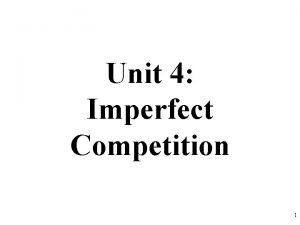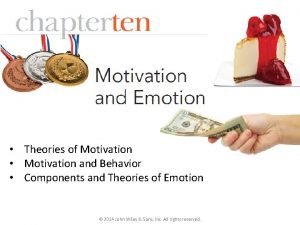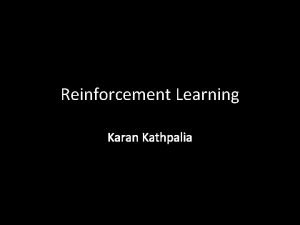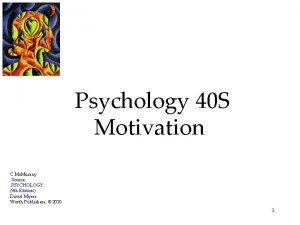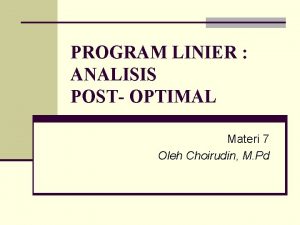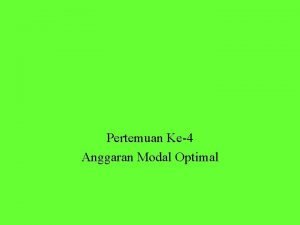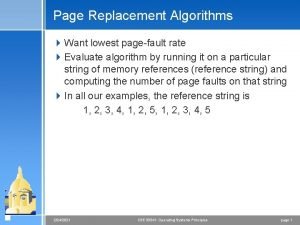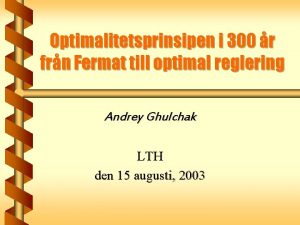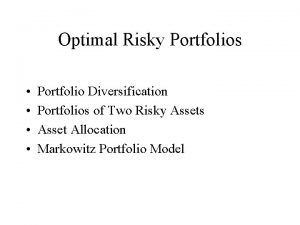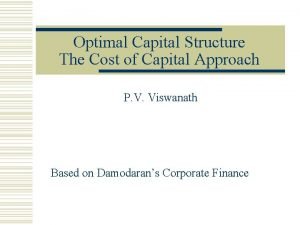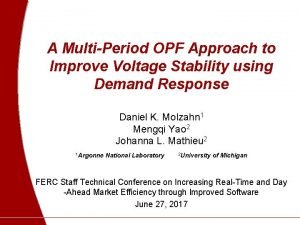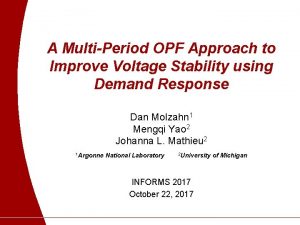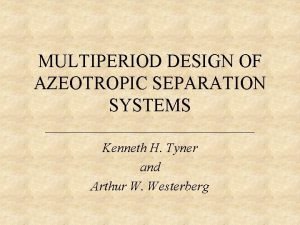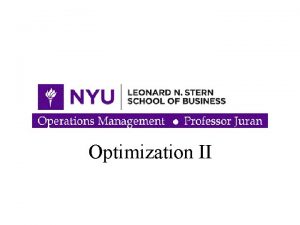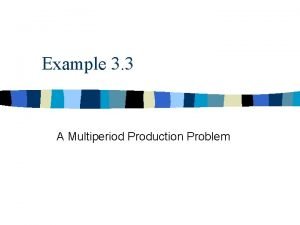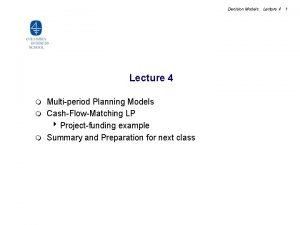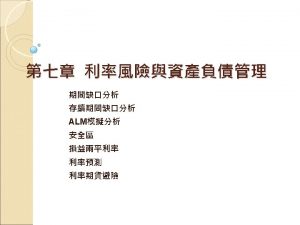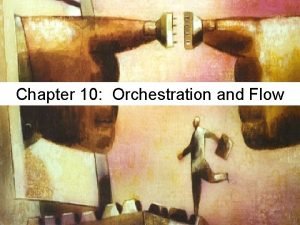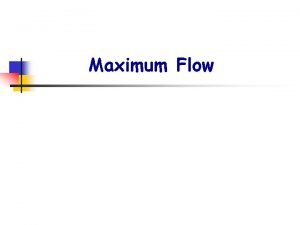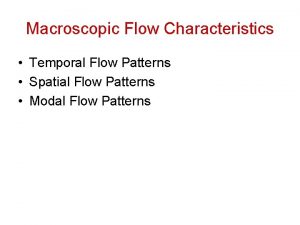A Multiperiod Optimal Power Flow to Improve Power









![Solution Approaches • Interior point method [Kodsi et al. 2007] • Require the Hessian Solution Approaches • Interior point method [Kodsi et al. 2007] • Require the Hessian](https://slidetodoc.com/presentation_image_h2/5ca05779b9483755b5eaa529f0f32ae9/image-10.jpg)
![Solution Approaches • Iterative nonlinear programming [Avalos et al. 2008] • Singular value decomposition Solution Approaches • Iterative nonlinear programming [Avalos et al. 2008] • Singular value decomposition](https://slidetodoc.com/presentation_image_h2/5ca05779b9483755b5eaa529f0f32ae9/image-11.jpg)
![Singular Value Sensitivities [Tiranuchit and Thomas 1988] 11 th Seminar for Next Generation - Singular Value Sensitivities [Tiranuchit and Thomas 1988] 11 th Seminar for Next Generation -](https://slidetodoc.com/presentation_image_h2/5ca05779b9483755b5eaa529f0f32ae9/image-12.jpg)





![Computation Time Eigenvalue Sensitivities [Smed 1993] 11 th Seminar for Next Generation - Mengqi Computation Time Eigenvalue Sensitivities [Smed 1993] 11 th Seminar for Next Generation - Mengqi](https://slidetodoc.com/presentation_image_h2/5ca05779b9483755b5eaa529f0f32ae9/image-18.jpg)












- Slides: 30

A Multiperiod Optimal Power Flow to Improve Power System Voltage Stability Using Demand Response Mengqi Yao University of Michigan 5/21/2019 The research was funded under NSF Grant #ECCS-1549670 11 th Seminar for Next Generation - Mengqi Yao 1

Background • Influences of fluctuating renewables on the power system Ø Introduce more variability in operating points Ø Reduce system inertia Ø Decrease the controllability of active power injections • Objective: Developing methods to coordinate flexible loads to improve electric power transmission system stability Demand response Power system stability 11 th Seminar for Next Generation - Mengqi Yao 2

Power System Stability • Definition: The ability to operate normally after a disturbance [Kundur et al. 2004] • Categories: Frequency stability, Voltage stability, Rotor angle stability the ability of a power system to maintain steady frequency after a significant imbalance between generation and load the ability of a power system to maintain acceptable voltages at all buses in common conditions and after disturbances 11 th Seminar for Next Generation - Mengqi Yao the ability of a power system to maintain synchronism when subjected to small disturbances. 3

Demand Response • Flexible loads: air conditioners, washing machines, dryers, etc. • What did we use DR for in the past? q Bring benefits to the electricity market, reduce costs [Borenstein 2002; Borenstein et al. 2002; Albadi et al. 2008] q Improve power system frequency stability Time shifting load to help balance supply and demand [Short et al. 2007; Callaway 2009; Zhang et al. 2013; Mathieu et al. 2013] • Our purpose: Using DR to improve voltage stability 11 th Seminar for Next Generation - Mengqi Yao 4

Our DR Strategy • Past work: Demand response based on load shedding [Berizzi et al. 1996; Feng et al. 1998; Huang et al. 2010; Yu et al. 2016] • Impair the comfort of consumers • Require change in system-wide generation • Our work: Demand response based on spatially shifting load, without load shedding, in order to improve voltage stability and not affect system frequency. 11 th Seminar for Next Generation - Mengqi Yao 5

Voltage Stability Margins 11 th Seminar for Next Generation - Mengqi Yao 6

Problem Description Stability margin improvement period Disturbance Energy payback period Spatio-temporal DR Problem 11 th Seminar for Next Generation - Mengqi Yao 7

Contributions • Our contributions: • We formulate a multiperiod OPF that uses spatio-temporal load shifting to improve voltage stability while considering the generation cost in the energy payback period; • We develop a computationally-tractable iterative linear programming solution algorithm usingular value sensitivities and benchmark it against the iterative nonlinear programming algorithm in literature; • We compare the cost and performance of spatio-temporal load shifting to that of generator actions and load shedding. 11 th Seminar for Next Generation - Mengqi Yao 8

Optimization Formulation SSV in period 1 cost in period 2 Computes the SSV in each period Total loading is constant Energy payback Constant power load model Maintain the SSV in period 2 AC power flow equations Engineering limits 11 th Seminar for Next Generation - Mengqi Yao 9
![Solution Approaches Interior point method Kodsi et al 2007 Require the Hessian Solution Approaches • Interior point method [Kodsi et al. 2007] • Require the Hessian](https://slidetodoc.com/presentation_image_h2/5ca05779b9483755b5eaa529f0f32ae9/image-10.jpg)
Solution Approaches • Interior point method [Kodsi et al. 2007] • Require the Hessian of • Semidefinite programming [Lavaei et al. 2007; Molzahn et al. 2016] AC power flow equations need to be relaxed; solution of relaxed problem may not be feasible 11 th Seminar for Next Generation - Mengqi Yao 10
![Solution Approaches Iterative nonlinear programming Avalos et al 2008 Singular value decomposition Solution Approaches • Iterative nonlinear programming [Avalos et al. 2008] • Singular value decomposition](https://slidetodoc.com/presentation_image_h2/5ca05779b9483755b5eaa529f0f32ae9/image-11.jpg)
Solution Approaches • Iterative nonlinear programming [Avalos et al. 2008] • Singular value decomposition • Around a given operating point, the approximate SSV is • Symbolic matrix multiplication is complex for large systems; nonlinear programming problem solved in each iteration may not be scalable 11 th Seminar for Next Generation - Mengqi Yao 11
![Singular Value Sensitivities Tiranuchit and Thomas 1988 11 th Seminar for Next Generation Singular Value Sensitivities [Tiranuchit and Thomas 1988] 11 th Seminar for Next Generation -](https://slidetodoc.com/presentation_image_h2/5ca05779b9483755b5eaa529f0f32ae9/image-12.jpg)
Singular Value Sensitivities [Tiranuchit and Thomas 1988] 11 th Seminar for Next Generation - Mengqi Yao 12

Iterative Linear Programming Algorithm 1. Linearize the objective function and constraints at the operating point; the decision variable is now the change in system states. 2. Solve the linear program to obtain the optimal change in system states; compute the new system states. 11 th Seminar for Next Generation - Mengqi Yao Ensure the accuracy of the linearization 13

Iterative Linear Programming Algorithm 3. Solve the AC power flow equation to compute the new operating point. 4. Iterations are terminated when the absolute value of the objective function of the linear program is less than a threshold. 11 th Seminar for Next Generation - Mengqi Yao 14

Results: 9 -bus system 11 th Seminar for Next Generation - Mengqi Yao 15

Results: 118 -bus system 11 th Seminar for Next Generation - Mengqi Yao 16

11 th Seminar for Next Generation - Mengqi Yao 17
![Computation Time Eigenvalue Sensitivities Smed 1993 11 th Seminar for Next Generation Mengqi Computation Time Eigenvalue Sensitivities [Smed 1993] 11 th Seminar for Next Generation - Mengqi](https://slidetodoc.com/presentation_image_h2/5ca05779b9483755b5eaa529f0f32ae9/image-18.jpg)
Computation Time Eigenvalue Sensitivities [Smed 1993] 11 th Seminar for Next Generation - Mengqi Yao 18

DR vs Generation actions Base case is to choose only DR load real power consumption in Period 1 Generator real power production/voltage magnitudes fixed, except slack bus 11 th Seminar for Next Generation - Mengqi Yao 19

DR vs Generation actions Case 1: slack bus manages change in losses Case 2: Loads manage change in losses 11 th Seminar for Next Generation - Mengqi Yao 20

DR vs Generation actions DR vs Generation Redispatch with ramp rates 11 th Seminar for Next Generation - Mengqi Yao 21

DR vs Generation actions Benefit of Voltage Control 11 th Seminar for Next Generation - Mengqi Yao 22

DR vs Generation actions Just loads vs everything (Optimistic) 11 th Seminar for Next Generation - Mengqi Yao 23

DR vs Generation actions Just Loads vs. Everything (Bounded) 11 th Seminar for Next Generation - Mengqi Yao 24

Cost of Different Strategies 11 th Seminar for Next Generation - Mengqi Yao 25

Comparison to Load Shedding P 5(MW) P 7(MW) P 9(MW) 90 100 125 Our DR strategy 147. 93 134. 32 29. 84 Load shedding 90 76. 89 92. 8 Initial the load would need to drop 17% to achieve the same SSV we obtain by spatial load shifting without any net load shedding 11 th Seminar for Next Generation - Mengqi Yao 26

Note on Different Stability Margin Distance to closest SNB SSV • Advantages • Captures any change in power directions • It can (easily) be included in optimization formulations • Captures any change in power directions • Gives direct information on the stability margin in the system parameter space. • Disadvantages • Only provides implicit information on the distance to the solvability boundary • May not be well behaved • Its numeric value is system dependent • There are multiple locally closest SNBs and it is difficult to determine the globally closest SNB. 11 th Seminar for Next Generation - Mengqi Yao 27

• M. Yao, D. K. Molzahn, and J. L. Mathieu. An Optimal Power Flow Approach to Improve Power System Voltage Stability Using Demand Response. In IEEE Transactions on Control of Network Systems (2019). Conference papers: 1. M. Yao, J. L. Mathieu, and D. K. Molzahn. Using Demand Response to Improve Power System Voltage Stability Margins. In IEEE Power. Tech, Manchester, United Kingdom. 2017. 2. M. Yao, D. K. Molzahn, and J. L. Mathieu. The Impact of Load Models in an Algorithm for Improving Voltage Stability via Demand Response. In Allerton. 2017. 3. K. Kasra, M. Yao, S. Roy, and J. L. Mathieu. Using Demand Response to Shape the Fast Dynamics of the Bulk Power Network. In IREP. 2017. 4. M. Yao, I. A. Hiskens, and J. L. Mathieu. Improving Power System Voltage Stability by Using Demand Response to Maximize the Distance to the Closest Saddle Node Bifurcation. In CDC. 2018. 11 th Seminar for Next Generation - Mengqi Yao 28

Future Work • Gain a better understanding of why the loading patterns change in the way they do. • Develop a formulation that incorporates both the voltage stability metrics and the small signal stability metrics and determines how different metrics impact the control of resources. 11 th Seminar for Next Generation - Mengqi Yao 29

Thank you for your time! Any questions? 11 th Seminar for Next Generation - Mengqi Yao 30
 How to improve cash flow gcse business
How to improve cash flow gcse business Cash flow options
Cash flow options Nvidia optimal power vs adaptive
Nvidia optimal power vs adaptive Power trianlge
Power trianlge Denitrogenation atelectasis
Denitrogenation atelectasis Venturi mask flow rate
Venturi mask flow rate O2 mask types
O2 mask types Turbulent flow vs laminar flow
Turbulent flow vs laminar flow Internal flow vs external flow
Internal flow vs external flow Ecological succession
Ecological succession Oikos meaning
Oikos meaning Dfd to structure chart
Dfd to structure chart Data flow structure
Data flow structure Rotational and irrotational flow definition
Rotational and irrotational flow definition Internal and external flow
Internal and external flow Data flow vs control flow
Data flow vs control flow Cheese preparation flow chart
Cheese preparation flow chart Control flow and data flow computers
Control flow and data flow computers Control flow vs transaction flow
Control flow vs transaction flow What is the socially optimal quantity
What is the socially optimal quantity Optimal arousal theory
Optimal arousal theory Karan kathpalia
Karan kathpalia Aron ralston motivation
Aron ralston motivation Post optimal
Post optimal Availability of products
Availability of products Bagaimanakah anggaran modal optimal ?
Bagaimanakah anggaran modal optimal ? Least recently used algorithm
Least recently used algorithm Contoh portofolio optimal
Contoh portofolio optimal 300 är optimal
300 är optimal Optimal risky portfolio weight formula
Optimal risky portfolio weight formula Example of capital structure
Example of capital structure



















